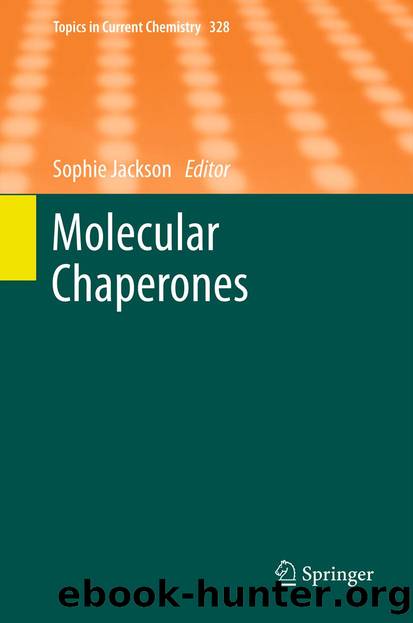Molecular Chaperones by Sophie Jackson

Author:Sophie Jackson
Language: eng
Format: epub
Publisher: Springer Berlin Heidelberg, Berlin, Heidelberg
13 Hsp70-Allosteric Effectors as Drugs
Consistent with its key role in protein homeostasis, Hsp70 chaperones have been implicated in numerous diseases. The various disease pathologies can be associated with “too much” Hsp70 activity (recycling of a toxic substrate) or with “too little” activity (failure to act on misfolded substrates). Thus, disease might arise from disruption of the delicately balanced proteostasis in either direction [163]. We will describe here just two disease classes, cancer and tauopathies, in which there is “too much” Hsp70 activity, so that one can conceivably aid in the therapy of these diseases by inhibiting Hsp70s.
All known tumors express elevated levels of Hsp70s [14]. One hypothesis is that the physiopathological features of the tumor microenvironment (low glucose, pH, and oxygen) mimic stress conditions [18, 19]. Alternatively, conformationally unstable oncoproteins may elicit a stress response [28, 164–167]. In cancer cells, Hsp70 stabilizes pro-survival factors [15–17] and inhibit cell death pathways [19, 22–26, 168, 169]. In addition, Hsp70 may prevent translocation of the apoptotic enhancer BAX from the cytosol to the mitochondria [170]. Hsp70 can also stabilize lysosomal membranes to inhibit the release of cathepsins and other enzymes which can induce cell death [171]. Hsp70 also plays roles in post-mitochondrial signaling pathways by antagonizing release of apoptogenic factors, such as cytochrome c and AIF [170]. Furthermore, Hsp70 can bind to and block the activity of APAF1 to avert the formation of the apoptosome and subsequent activation of caspase enzymes [172]. Finally, Hsp70 also directly participates in oncogenic transformation [19]. One of the likely responsible mechanisms is the interaction of mitochondrial Hsp70 (mt-Hsp70) with mutant and wild-type tumor suppressor proteins, such as p53 [28, 166, 167, 173–175], and Rb107 [176]. The malignant transformation has been explained, in part, by the inactivation of p53 tumor suppressor protein by mt-Hsp70 [27]. In particular, wild-type p53 and mt-Hsp70 co-localize in the cytoplasm in several human cancers (undifferentiated neuroblastoma, retinoblastoma, colorectal and hepatocellular carcinomas, and glioblastoma) [28]. Together these observations support a model in which Hsp70 expression is anti-apoptotic and required for cancer cell viability. In addition, high expression of Hsp70 also confers resistance to chemotherapy, radiation, and hyperthermia therapy in breast cancer [18, 177]. Together, these observations suggest that Hsp70 is an important, potential drug target in cancer.
In support of these ideas, knockdown of Hsp70 chaperone expression [178, 179] or inhibition by small molecules [180] is lethal to cancer cell lines. For example, Hsp70 inhibitors generated by the Wipf and Brodsky groups have anti-proliferative activity against lung cancer cells [181] and Hsp70 inhibitors synthesized by the biotechnology company, Vernalis, have potent activity against cancer cells [182]. Moreover, a natural product, epigallocatechin gallate, interacts with Hsp70 [183] and triggers apoptosis in tumor cells [183]. MKT-077, a cationic rhodacyanine dye analog, which binds to Hsp70 [184], has activity against CX-1 colon carcinoma cells (IC50 ~ 7 μM), but has no effect on normal epithelial cells [180]. Mechanistic studies indicated that MTK-077 inhibits the deleterious interaction of mt-Hsp70 with p53 by binding to the mt-Hsp70 NBD [167, 185]. These studies
Download
This site does not store any files on its server. We only index and link to content provided by other sites. Please contact the content providers to delete copyright contents if any and email us, we'll remove relevant links or contents immediately.
| Automotive | Engineering |
| Transportation |
Whiskies Galore by Ian Buxton(41879)
Introduction to Aircraft Design (Cambridge Aerospace Series) by John P. Fielding(33064)
Small Unmanned Fixed-wing Aircraft Design by Andrew J. Keane Andras Sobester James P. Scanlan & András Sóbester & James P. Scanlan(32743)
Craft Beer for the Homebrewer by Michael Agnew(18140)
Turbulence by E. J. Noyes(7936)
The Complete Stick Figure Physics Tutorials by Allen Sarah(7307)
Kaplan MCAT General Chemistry Review by Kaplan(6867)
The Thirst by Nesbo Jo(6828)
Bad Blood by John Carreyrou(6552)
Modelling of Convective Heat and Mass Transfer in Rotating Flows by Igor V. Shevchuk(6391)
Learning SQL by Alan Beaulieu(6211)
Weapons of Math Destruction by Cathy O'Neil(6146)
Man-made Catastrophes and Risk Information Concealment by Dmitry Chernov & Didier Sornette(5921)
Digital Minimalism by Cal Newport;(5664)
Life 3.0: Being Human in the Age of Artificial Intelligence by Tegmark Max(5474)
iGen by Jean M. Twenge(5366)
Secrets of Antigravity Propulsion: Tesla, UFOs, and Classified Aerospace Technology by Ph.D. Paul A. Laviolette(5309)
Design of Trajectory Optimization Approach for Space Maneuver Vehicle Skip Entry Problems by Runqi Chai & Al Savvaris & Antonios Tsourdos & Senchun Chai(5011)
Pale Blue Dot by Carl Sagan(4912)
